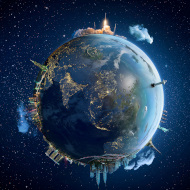Climate change isn’t coming……it’s here. The signs are very real and very sobering.
In just 2019 alone, here’s what scientists have documented:
- Arctic permafrost is melting at a rate that is far faster that we’d expected — 70 years early, in fact. This matters because the organic-rich permafrost holds an estimated 1,500 billion tons of carbon. That’s about twice as much carbon in the atmosphere, and three times as much carbon than that stored in all the world’s forests. It’ll be releasing CO2, methane and dormant viruses and spores (e.g. anthrax). Once the permafrost melts, CO2 levels will become a runaway train that humanity may not be able to stop.
- Greenland is losing far more ice than projected. It lost 4.1 billion tons (3.7 billion metric tons) of ice on June 17 alone. not only is the ice melting very fast, it has more time to melt this summer than it would in a climate system that wasn’t so unbalanced. Since 1972, Greenland has contributed about half an inch (1.4 centimeters) to sea-level rise. Even The Economist magazine — not a Cassandra when it comes to the environment — acknowledges that the loss of Greenland ice is worrying.
- Our planet’s atmosphere has more measurable CO2 than has ever been recorded in human history…..more than existed millions of years ago. This finding is based upon data developed by the Scripps Institution of Oceanography at the University of California, San Diego.
- The number of birds in the United States and Canada has fallen by 29 percent since 1970, as reported in Science, a reputable scientific journal. The article reports that there are 2.9 billion fewer birds now than there were 50 years ago. The study, based on a broad survey of more than 500 species, reports serious losses even among such common birds as robins and sparrows. No one knows what is causing the loss, but it portends for significant ecological impacts because of how integral these common birds are to the North American ecosystem.
- The Himalayan Mountains are losing its glaciers at an unprecedented rate. Within the last 40 years, the rate of glacial melt has doubled in these mountains. Because they provide water for over 1.6 billion people, the loss of glaciers can have devastating impacts on the Indo-Chinese region.
- An Australian think tank has concluded that within the next 30 years, we will reach a point of no return. Once we’ve arrived at a 3 degree (Celsius) increase in global temperatures, the study finds that one billion people would be forced to attempt to relocate from unlivable conditions, and two billion would face scarcity of water supplies. Agriculture would collapse in the sub-tropics, and food production would suffer dramatically worldwide. The internal cohesion of nation-states like the US and China would unravel.
- In September 2019, the U.S.experienced six named storms whirling simultaneously in the Atlantic and Pacific. While Humberto and Kiko were spinning in the Atlantic and Eastern Pacific, four new tropical cyclones formed Tuesday: Imelda and Jerry in the Atlantic Basin, and Mario and Lorena in the Eastern Pacific Basin,” the Weather Channel reported. This combined number of active storms in both basins was believed to tie a modern record, set in September 1992, according to National Hurricane Center .
If you need any additional convincing, a pair of recent studies demonstrate that the rise in global temperatures over the past 150 years has been far more rapid and widespread than any warming period in the past 2,000 years — a finding that undercuts claims that today’s global warming isn’t necessarily the result of human activity. In a paper in Nature and in a companion paper in Nature Geoscience, scientists establish that climate changes in earlier times were much smaller in scope than the near-global reach of current human-induced warming. These studies are summarized and are compulsory reading for anyone still on the climate change fence.
Please don’t shoot the messenger.
Instead, please practice the following steps to reduce your contribution to our planet’s carbon dioxide poisoning:
- Vote! Some of our politicians are beholden to interests that rely upon their ability to poison our planet. You can change that.
- Plant trees, not lawns, on any property you own. And install drip irrigation when you are doing that planting.
- Don’t eat beef or lamb. Livestock generates about 15% of all manmade global greenhouse gases. Plus, your body will thank you.
- Use less electricity — unless you produce it yourself from renewable sources like PV arrays or windmills. Here’s how to conserve energy.
- Buy locally grown produce that doesn’t come from far distances. You can find amazing produce throughout San Diego County.
- Purchase your clothing at consignment shops
- Use public transportation, rideshares or bicycles, when possible. Even better: walk! Here are some options.
- Avoid flying, if driving is an option. Listen to podcasts during your drive — it will go faster. Rethink whether you want to fly long distances. Staycation anyone?
If you need to pollute, at least buy a carbon offset to help undo the damage you are doing. Some nonprofits, such as Myclimate , Cotap and Terrapass, fund renewable projects that reduce our CO2 emissions and help restore our planet’s health.

